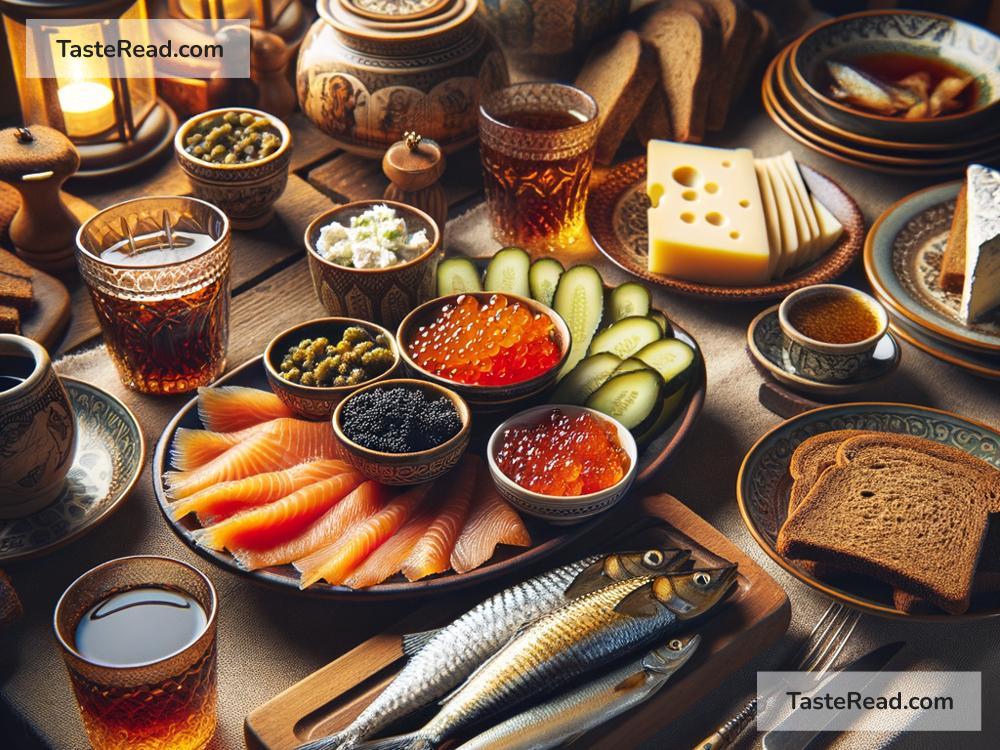Discovering the Multifaceted World of Russian Zakuski
Russian cuisine is filled with flavors, history, and traditions. Among its many culinary treasures, one standout is zakuski – a delightful assortment of appetizers served to start a meal. Derived from the Russian word “zakusit,” which means “to take a small bite,” zakuski are more than just snacks. They are a cultural experience, a social gathering, and a way to showcase the diversity of Russian food. Let’s dive into the fascinating world of zakuski and learn more about these tasty bites.
What Are Zakuski?
Zakuski (pronounced zah-KOOS-kee) refers to a variety of cold and hot appetizers, often served before the main meal. Imagine a table filled with small plates, each carrying something delicious and distinct. Zakuski are designed to whet your appetite and can be paired with drinks, especially vodka, which is a classic accompaniment in Russia.
This tradition of serving zakuski has deep roots in Russian culture. Centuries ago, they were served as refreshments to travelers or guests stopping by someone’s home. Over time, zakuski evolved into an essential part of celebratory feasts, such as weddings, New Year’s Eve dinners, and holiday gatherings.
The Zakuski Table: A Feast for the Eyes
One of the first things you’ll notice about zakuski is how beautifully they are presented. A zakuski table is like a vibrant mosaic of colors, textures, and flavors. From salty and smoky to creamy and tangy, each dish has its own unique character. The variety not only appeals to the taste buds but also creates an inviting and festive atmosphere.
Zakuski can be as simple or elaborate as you like. Some families prepare quick dishes using store-bought ingredients, while others craft traditional recipes handed down through generations. Regardless of the preparation style, they reflect the host’s hospitality and pride in sharing Russian culinary traditions.
Key Ingredients in Zakuski
The world of zakuski is vast, but certain ingredients appear often in these dishes. Here are some of the most common staples:
-
Fish: Russians love fish, especially smoked and cured varieties. Expect to see herring, salmon, mackerel, and other seafood on the zakuski table. Herring is often dressed in oil or paired with onions for a classic zakuski dish.
-
Pickles: Russians have a knack for pickling, so cucumbers, mushrooms, and even tomatoes often make an appearance. Tangy pickles add crunch and contrast to the richer items on the table.
-
Eggs: Deviled eggs or boiled eggs can be dressed up with mayonnaise, herbs, or caviar for a luxurious touch.
-
Bread: Rye bread (known as “black bread” in Russia) is an essential part of zakuski. Its hearty taste and dense texture pair perfectly with fish and spreads.
-
Spreads: Creamy spreads made from butter, cheese, or herbs are common. These are great for smearing onto bread or crackers.
-
Caviar: Perhaps the most iconic zakuski ingredient, caviar is a prized delicacy. Served on tiny blini (pancakes) or bread, it symbolizes luxury.
Popular Zakuski Dishes to Try
While there are endless variations of zakuski, here are some beloved classics:
1. Selyodka Pod Shuboy (Herring Under a Fur Coat)
This layered salad is a zakuski favorite. It features pickled herring, potatoes, carrots, beets, and mayonnaise, all arranged in colorful layers. The name refers to the beets, which “cover” the other ingredients like a fur coat. Don’t let the unusual combination fool you – it’s delicious!
2. Olivier Salad
Known as the Russian potato salad, Olivier is a dish of boiled potatoes, carrots, peas, eggs, and meat (such as chicken or sausage), mixed with mayonnaise. This creamy salad is a staple at parties and holiday gatherings.
3. Blini with Caviar
Thin pancakes, or blini, are served with butter, sour cream, and caviar. The combination of fluffy blini and salty caviar creates an unforgettable bite.
4. Pickled Mushrooms
Wild mushrooms preserved in brine are a common zakuski item. Their earthy flavor adds depth to the table.
5. Smoked Salmon
Thin slices of salmon, often served with dill and lemon, bring a touch of sophistication to the zakuski spread.
6. Stuffed Tomatoes or Peppers
Vegetables filled with mixtures of cheese, herbs, or meats make for tasty and colorful bites.
Zakuski and Vodka: The Perfect Pairing
In Russia, zakuski are often served with vodka. The strong, clean flavor of vodka complements the salty, tangy, and rich elements of zakuski dishes. Traditionally, guests take a small sip of vodka and follow it with a bite from their plate. This pairing enhances the experience and adds a social aspect to the meal.
A Gateway to Russian Culture
Zakuski are more than just food – they’re a way of bringing people together. Whether it’s a casual evening at home or a grand celebration, the zakuski table fosters conversation, laughter, and connection. Each dish tells a story, reminding guests of Russia’s culinary heritage and its love for hospitality.
If you ever find yourself at a Russian feast, don’t miss the opportunity to explore the zakuski table. It’s a journey through textures, tastes, and traditions that will fill your plate and heart alike. And if you’re feeling adventurous, why not recreate this experience at home? Pick a few dishes and enjoy a Russian-inspired gathering with friends and family. You might discover that zakuski are more than just starters – they’re a feast worth celebrating!


